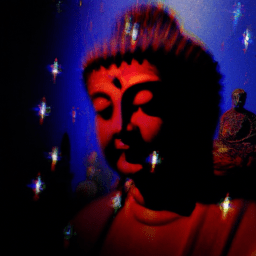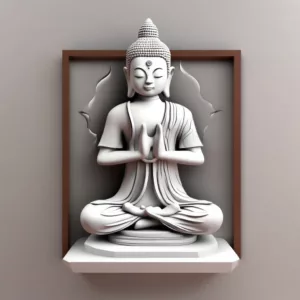Mahamudra means the great seal. It’s the peak experience, or the peak realization, on the path of Dharma where one sees phenomena and mind as inseparable from emptiness and luminosity.
Table of Contents
Mahamudra Tantra

Mahamudra is one of the most treasured and important traditions in the Tibetan Buddhist canon of practices. It has multiple forms and ways of approach, beginning with the two accumulations of merit and wisdom and the five paths, progressing to deity meditation and the inner yogas, the six yogas in Naropa, and culminating in the direct experience of formless Mahamudra.
Mahamudra began with Tilopa generally, who seems to have received it from a non-physical Buddha and then passed it on to his primary disciple Naropa, who passed it on to Marpa, who took it to Tibet.
There are multiple forms of Mahamudra. The primary would be the meditation on emptiness, on the form of the deity, and as mixing the mind with the guru by being close to the guru. The practice instructions on seeing the essence of mind, or the pointing out of the nature of mind is the key aspect. The progression of the path is called the four yogas of Mahamudra. And there is also Samata and Vipassana Mahamudras.

Flow, the profound mental state, also called Peak Performance, can be attained with meditation, and can be ‘triggered’ at will, with enough discipline. Guide to Flow Mastery will teach you how.
Shamatha Mahamudra is the practice of training the mind through various methods such as the nine stages, learning to meditate properly, gaining the ability and skill to meditate on ever subtler objects of meditation, and then resting in space, resting on no object whatsoever.
It’s very difficult because the mind tends to space out or to think of other things, to either space out to think of other things, to become sleepy, to become hyperactive, to plan the past, the future, and so forth. Generally, this would be more or less synonymous with Sutra Mahamudra.
Mahamudra Benefits
The benefits of Mahamudra are seeing the essential reality. Bliss, clarity, and nonthought are temporary experiences along the journey, but they don’t last. Ease, relaxation, compassion, and great wisdom arise from successful practice. Ultimately, one is liberated from suffering and attains buddhahood.
Mahamudra pdf
Mahamudra Symbol

Symbol with word ‘Mahamudra’ in script. There is no official Symbol of the system, but this one is often shown in connection to the philosophy and practice.
Mahamudra Meaning
The term means the great seal, symbol or imprint. It refers all phenomena as being suffused, sealed, or imprinted with luminous emptiness. Mahamudra indicates the inseparability of relative and ultimate perceptions of reality.
Guru Yoga Mahamudra
Guru Yoga means to mix the mind with the mind of the guru. The guru can have many manifestations. There is of course the human guru, but this is also called, which is very important, the example guru.
The true guru is the nature of your own mind, the deepest character of your own mind, which is pure wisdom. This approach dissolves the barriers between the conceptual fabricated mind of oneself as a sentient being and the greater pure awareness which is beyond being and non-being. This awareness has no self, it has no entity, there is no physical substance to it, and yet it arises as a manifestation of everything.
You can practice Guru Yoga with the human guru by simply being around your teacher a lot and concentrating your mind on that.
Other forms of Guru Yoga are the visualization of the guru, typically on top of the head, and then with some mantra, visualizing that blessings descend, the blessings are wisdom, they dissolve the dualistic barrier, they enter the mind, they awaken the mind to the essential nature. The blessings help one to understand what is being experienced, which is a non-conceptual reality that cannot be explained in words.
How to meditate like a yogi
and enter profound samadhi
Deity Mahamudra
The next method of progression is the deity yoga, meditating on the yidam. It’s a more advanced type of Guru Yoga, essentially. The yidam is typically conferred on you by your human guru, then you meditate on it, especially invoking the critical elements of the hand implements, the masculine-feminine principle, the seed syllable, the arising and dissolution, and so forth to teach the mind about the great symbol.
Other things occur also with deity meditation, such as purifying the states of death and rebirth and so forth. At the end of a session, meditative session, one dissolves the deity to counter the extremes of eternalism. You don’t grasp the deity as a form of identity or as a substantive reality of the universe, but it’s important to give rise to the form of the deity, to overcome the extremity of nihilism.
The yidam-deity also purifies the grasping of reality as truly existent, and physical reality as being generally solid and unchanging. The deity is made of light and also purifies negative conceptions about the self. The yidam is completely enlightened. To see oneself as the deity helps to see oneself as completely enlightened.
Without the proper empowerment and instructions from a qualified guru, such deity practices are at best useless or worse dangerous. They can reinforce the ego or even put one in a psychotic state. This takes a very diligent practice and retreat for weeks or months in order to do this to oneself, but it has happened.
This stage – the form of the deity arising and dissolving – is referred to as Maha Yoga. There’s a lot of emphasis on precise visualizing of details. The deity yoga generates tremendous clarity when done properly and diligently.



The next stage is Anu Yoga, typically associated with the six yogas of Naropa, tummo, the primary practice, is the inner yoga concentrating on the chakras/centers, the nadis/channels, the prana/energy, and the subtle control of all that with what’s called the Bindu – roughly the consciousness.
These practices can be very simple and non-complicated or they can be extremely complex. There are whole systems of how the inner and outer realities meet and form each other and affect each other – including cycles of days and nights and seasons of the year and times of life and single breaths and so forth.
In Anu Yoga or tummo one works with what’s called the Vajra body, which is interestingly strongly associated with speech as well. Instead of working with the body as a solid physical reality or even a visualized form of the deity, though that is a part of it, one works primarily with the energies and bringing energies into quiescence and purifying all the negative karma that is embedded in the pranic field through various breathing exercises.
As a note, Wim Hof is said to practice tummo or Chandali (Tib.). This is not the case. I have practiced tummo and I’ve done some of the Wim Hof breathing. They are not even remotely the same. There is some superficial resemblance of just the breathing exercises, but beyond that a whole world of tummo has been developed over centuries that is not part of Wim Hof’s methods.
4 Yogas of Mahamudra
Lastly are the four yogas of Mahamudra. The four stages are
| One-pointedness | Samadhi, perfection of shamatha |
| Simplicity | Direct Perception of Emptiness |
| One Taste | Union of Luminosity and emptiness |
| Non-meditation | Buddhahood |
One-pointedness is essentially a mastery of the Mahayana vipashyana. It’s the shamatha of resting in space, the ability to maintain the mind’s focus without an object, simply settled in its own essential quality.
Simplicity is the perception of emptiness in a direct manner. When the meditator meditates, emptiness is seen regularly. It’s also perceived directly. Each of these stages has lesser, middling, and greater stages to them for a total of twelve.
The third stage is one-taste. At this point for the meditator, everything in his experience is suffused with emptiness. The world no longer seems solid or fixed.
At the ultimate stage of non-meditation, this is stabilized. Simply the direct experience of reality has been mastered. There’s no need to practice on the cushion or in a formal setting at all. The culmination of non-meditation is complete enlightenment of course.
The techniques are detailed in this book, teaching you how to stabilize the mind in shamatha. It’s a large book, but it’s quite profound. Takpo Tashi Namgyal’s Moonbeams of Mahamudra, translated by Elizabeth Callahan.
Vipashyana Mahamudra
The Vipassana methods are to settle the mind of meditation and to look at the essence of the mind. A series of seemingly simple questions are asked and these each clarify different aspects of reality that we tend to grasp onto as being real. Most of them focus on the mind itself, however there are other ways of doing it.
Other questions, such as “Where is the mind?” “Where is it located?” “Where is this thought located?” “Does the thought arise?” “Does it dwell?” “Does it cease?” “What color is it?” You pick one of these questions, depending on where you’re at in your practice, and investigate from a naive perspective.
Where is the mind?
What color is the thought?
Just literally ask the question and see, “Where is the mind located?” “Is it inside the body?” “Is it in the heart?” “Is it somewhere else?” “Is it in the head?” “If it’s in the head, how come we can feel things in the rest of our body and see things outside of our body?” “Is it just the brain or is there something more to it?”
Don’t get too many questions going on, however. The point is to be very simple and just keep a single question going at once, and it should be an experiential question generally. Such as, “Does the mind arise?” “Does it dwell or abide?” “Does the mind cease?” Or, “Does a thought do that?” “What is a thought?” “Can you see the thought directly?” “Can you see the essence of it?”
Conclusion
Practicing this method leads to profound experiences. These can be destabilizing, so it’s best to accomplish a very good skill in shamatha and in other aspects of the path, such as the six paramitas. These are stabilizing and grounding. They give the path context and meaning.
The meditation tends to remove context and meaning, so without that grounding and structure of virtue, merit, wisdom, devotion, and so forth, if one begins to have these profound experiences, it can be very destabilizing for the mind. These are highest meditations, and it’s not a good idea to play with them casually. That being said, good luck.
faq
What is the meaning of Mahamudra?
The meaning of Mahamudra is the Great Seal or Imprint. All phenomena are pervaded by luminosity-emptiness inseparable.
How to do Mahamudra meditation?
Mahamudra meditation has multiple methods. Tilopa’s is Do Not
-Recall the past
-Anticipate the future
-Ponder the Present
-Analyze Experience
-Manipulate
-DO rest the mind at ease
What are the 4 stages of Mahamudra?
The 4 stages of Mahamudra are
-One-pointedness (perfect focus)
-Simplicity (seeing emptiness
– One Taste (union of emptiness and Luminosity)
– Non-meditation (Buddhahood)
Shambhavi Mahamudra
Shambhavi Mahamudra refers to a yogic practice in Hinduism with the Mahamudra Asana and a deep breathing exercise.
What is Mahamudra Hatha Yoga?
Mahamudra Hatha Yoga is a specific posture and breathing method to utilize sexual energy for insight.

May all beings be happy
May all beings be peaceful
May all beings be safe
May all beings awaken to the light of their true nature
May all beings be free







